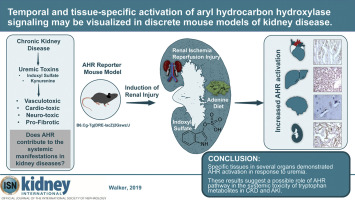当前位置:
X-MOL 学术
›
Kidney Int.
›
论文详情
Our official English website, www.x-mol.net, welcomes your
feedback! (Note: you will need to create a separate account there.)
Temporal and tissue-specific activation of aryl hydrocarbon receptor in discrete mouse models of kidney disease.
Kidney International ( IF 14.8 ) Pub Date : 2019-10-30 , DOI: 10.1016/j.kint.2019.09.029 Joshua A Walker 1 , Sean Richards 2 , Mostafa E Belghasem 3 , Nkiruka Arinze 2 , Sung Bok Yoo 2 , Joseph Y Tashjian 2 , Stephen A Whelan 4 , Norman Lee 4 , Vijaya B Kolachalama 5 , Jean Francis 2 , Katya Ravid 5 , David Sherr 6 , Vipul C Chitalia 7
Kidney International ( IF 14.8 ) Pub Date : 2019-10-30 , DOI: 10.1016/j.kint.2019.09.029 Joshua A Walker 1 , Sean Richards 2 , Mostafa E Belghasem 3 , Nkiruka Arinze 2 , Sung Bok Yoo 2 , Joseph Y Tashjian 2 , Stephen A Whelan 4 , Norman Lee 4 , Vijaya B Kolachalama 5 , Jean Francis 2 , Katya Ravid 5 , David Sherr 6 , Vipul C Chitalia 7
Affiliation

|
Emerging evidence in animal models of chronic kidney disease (CKD) implicates Aryl Hydrocarbon Receptor (AHR) signaling as a mediator of uremic toxicity. However, details about its tissue-specific and time-dependent activation in response to various renal pathologies remain poorly defined. Here, a comprehensive analysis of AHR induction was conducted in response to discrete models of kidney diseases using a transgenic mouse line expressing the AHR responsive-promoter tethered to a β-galactosidase reporter gene. Following validation using a canonical AHR ligand (a dioxin derivative), the transgenic mice were subjected to adenine-induced and ischemia/reperfusion-induced injury models representing CKD and acute kidney injury (AKI), respectively, in humans. Indoxyl sulfate was artificially increased in mice through the drinking water and by inhibiting its excretion into the urine. Adenine-fed mice showed a distinct and significant increase in β-galactosidase in the proximal and distal renal tubules, cardiac myocytes, hepatocytes, and microvasculature in the cerebral cortex. The pattern of β-galactosidase increase coincided with the changes in serum indoxyl sulfate levels. Machine-learning-based image quantification revealed positive correlations between indoxyl sulfate levels and β-galactosidase expression in various tissues. This pattern of β-galactosidase expression was recapitulated in the indoxyl sulfate-specific model. The ischemia/reperfusion injury model showed increase in β-galactosidase in renal tubules that persisted despite reduction in serum indoxyl sulfate and blood urea nitrogen levels. Thus, our results demonstrate a relationship between AHR activation in various tissues of mice with CKD or AKI and the levels of indoxyl sulfate. This study demonstrates the use of a reporter gene mouse to probe tissue-specific manifestations of uremia in translationally relevant animal models and provide hypothesis-generating insights into the mechanism of uremic toxicity that warrant further investigation.
中文翻译:

肾病离散小鼠模型中芳基烃受体的时间和组织特异性激活。
慢性肾病 (CKD) 动物模型中出现的新证据表明,芳基烃受体 (AHR) 信号是尿毒症毒性的介质。然而,关于其响应各种肾脏病理的组织特异性和时间依赖性激活的细节仍然不清楚。在这里,使用表达与 β-半乳糖苷酶报告基因相连的 AHR 响应启动子的转基因小鼠品系,针对肾脏疾病的离散模型对 AHR 诱导进行了全面分析。在使用典型的 AHR 配体(一种二恶英衍生物)进行验证后,转基因小鼠接受腺嘌呤诱导和缺血/再灌注诱导的损伤模型,分别代表人类 CKD 和急性肾损伤 (AKI)。通过饮用水和抑制其排泄到尿液中,小鼠体内的硫酸吲哚酚人为增加。腺嘌呤喂养小鼠的近端和远端肾小管、心肌细胞、肝细胞和大脑皮层微血管系统中的 β-半乳糖苷酶明显显着增加。β-半乳糖苷酶增加的模式与血清硫酸吲哚酚水平的变化一致。基于机器学习的图像量化揭示了硫酸吲哚酚水平与各种组织中 β-半乳糖苷酶表达之间的正相关。这种 β-半乳糖苷酶表达模式在硫酸吲哚酚特异性模型中得到了概括。缺血/再灌注损伤模型显示,尽管血清硫酸吲哚酚和血尿素氮水平降低,但肾小管中 β-半乳糖苷酶的增加仍然存在。因此,我们的结果证明了患有 CKD 或 AKI 的小鼠的各种组织中 AHR 激活与硫酸吲哚酚水平之间的关系。本研究展示了使用报告基因小鼠在翻译相关动物模型中探测尿毒症的组织特异性表现,并提供了对尿毒症毒性机制的假设生成见解,值得进一步研究。
更新日期:2019-11-01
中文翻译:

肾病离散小鼠模型中芳基烃受体的时间和组织特异性激活。
慢性肾病 (CKD) 动物模型中出现的新证据表明,芳基烃受体 (AHR) 信号是尿毒症毒性的介质。然而,关于其响应各种肾脏病理的组织特异性和时间依赖性激活的细节仍然不清楚。在这里,使用表达与 β-半乳糖苷酶报告基因相连的 AHR 响应启动子的转基因小鼠品系,针对肾脏疾病的离散模型对 AHR 诱导进行了全面分析。在使用典型的 AHR 配体(一种二恶英衍生物)进行验证后,转基因小鼠接受腺嘌呤诱导和缺血/再灌注诱导的损伤模型,分别代表人类 CKD 和急性肾损伤 (AKI)。通过饮用水和抑制其排泄到尿液中,小鼠体内的硫酸吲哚酚人为增加。腺嘌呤喂养小鼠的近端和远端肾小管、心肌细胞、肝细胞和大脑皮层微血管系统中的 β-半乳糖苷酶明显显着增加。β-半乳糖苷酶增加的模式与血清硫酸吲哚酚水平的变化一致。基于机器学习的图像量化揭示了硫酸吲哚酚水平与各种组织中 β-半乳糖苷酶表达之间的正相关。这种 β-半乳糖苷酶表达模式在硫酸吲哚酚特异性模型中得到了概括。缺血/再灌注损伤模型显示,尽管血清硫酸吲哚酚和血尿素氮水平降低,但肾小管中 β-半乳糖苷酶的增加仍然存在。因此,我们的结果证明了患有 CKD 或 AKI 的小鼠的各种组织中 AHR 激活与硫酸吲哚酚水平之间的关系。本研究展示了使用报告基因小鼠在翻译相关动物模型中探测尿毒症的组织特异性表现,并提供了对尿毒症毒性机制的假设生成见解,值得进一步研究。











































 京公网安备 11010802027423号
京公网安备 11010802027423号